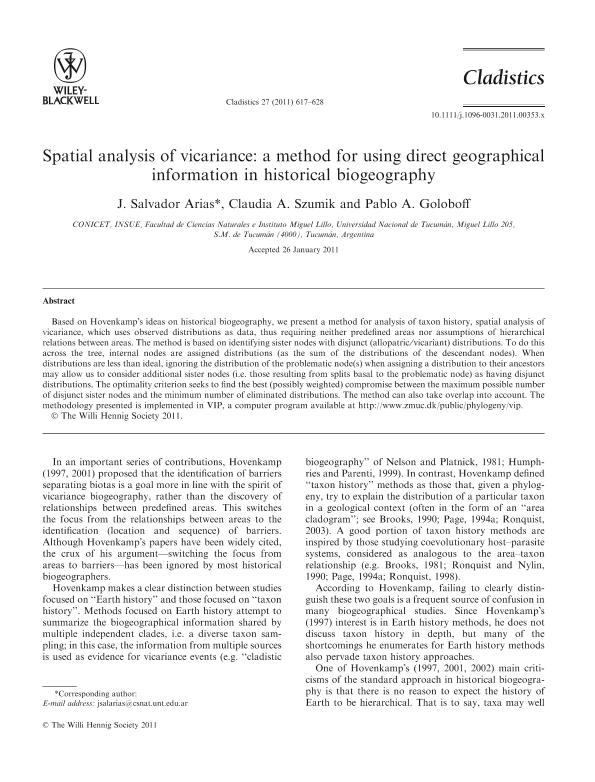Mostrar el registro sencillo del ítem
dc.contributor.author
Arias Becerra, Joan Salvador

dc.contributor.author
Szumik, Claudia Adriana

dc.contributor.author
Goloboff, Pablo Augusto

dc.date.available
2019-02-14T18:01:39Z
dc.date.issued
2011-12
dc.identifier.citation
Arias Becerra, Joan Salvador; Szumik, Claudia Adriana; Goloboff, Pablo Augusto; Spatial analysis of vicariance: A method for using direct geographical information in historical biogeography; Wiley Blackwell Publishing, Inc; Cladistics; 27; 6; 12-2011; 617-628
dc.identifier.issn
0748-3007
dc.identifier.uri
http://hdl.handle.net/11336/70196
dc.description.abstract
Based on Hovenkamp's ideas on historical biogeography, we present a method for analysis of taxon history, spatial analysis of vicariance, which uses observed distributions as data, thus requiring neither predefined areas nor assumptions of hierarchical relations between areas. The method is based on identifying sister nodes with disjunct (allopatric/vicariant) distributions. To do this across the tree, internal nodes are assigned distributions (as the sum of the distributions of the descendant nodes). When distributions are less than ideal, ignoring the distribution of the problematic node(s) when assigning a distribution to their ancestors may allow us to consider additional sister nodes (i.e. those resulting from splits basal to the problematic node) as having disjunct distributions. The optimality criterion seeks to find the best (possibly weighted) compromise between the maximum possible number of disjunct sister nodes and the minimum number of eliminated distributions. The method can also take overlap into account. The methodology presented is implemented in VIP, a computer program available at.
dc.format
application/pdf
dc.language.iso
eng
dc.publisher
Wiley Blackwell Publishing, Inc

dc.rights
info:eu-repo/semantics/openAccess
dc.rights.uri
https://creativecommons.org/licenses/by-nc-sa/2.5/ar/
dc.subject
Taxon History
dc.subject
Hovenkamp
dc.subject
Spatial Analysis
dc.subject
Geographical Information
dc.subject.classification
Otras Ciencias Biológicas

dc.subject.classification
Ciencias Biológicas

dc.subject.classification
CIENCIAS NATURALES Y EXACTAS

dc.title
Spatial analysis of vicariance: A method for using direct geographical information in historical biogeography
dc.type
info:eu-repo/semantics/article
dc.type
info:ar-repo/semantics/artículo
dc.type
info:eu-repo/semantics/publishedVersion
dc.date.updated
2019-02-12T14:17:30Z
dc.journal.volume
27
dc.journal.number
6
dc.journal.pagination
617-628
dc.journal.pais
Reino Unido

dc.journal.ciudad
Londres
dc.description.fil
Fil: Arias Becerra, Joan Salvador. Consejo Nacional de Investigaciones Científicas y Técnicas. Centro Científico Tecnológico - Tucumán. Unidad Ejecutora Lillo; Argentina. Universidad Nacional de Tucumán. Facultad de Ciencias Naturales e Instituto Miguel Lillo. Instituto Superior de Entomología; Argentina
dc.description.fil
Fil: Szumik, Claudia Adriana. Consejo Nacional de Investigaciones Científicas y Técnicas. Centro Científico Tecnológico - Tucumán. Unidad Ejecutora Lillo; Argentina. Universidad Nacional de Tucumán. Facultad de Ciencias Naturales e Instituto Miguel Lillo. Instituto Superior de Entomología; Argentina
dc.description.fil
Fil: Goloboff, Pablo Augusto. Consejo Nacional de Investigaciones Científicas y Técnicas. Centro Científico Tecnológico - Tucumán. Unidad Ejecutora Lillo; Argentina. Universidad Nacional de Tucumán. Facultad de Ciencias Naturales e Instituto Miguel Lillo. Instituto Superior de Entomología; Argentina
dc.journal.title
Cladistics

dc.relation.alternativeid
info:eu-repo/semantics/altIdentifier/doi/https://dx.doi.org/10.1111/j.1096-0031.2011.00353.x
dc.relation.alternativeid
info:eu-repo/semantics/altIdentifier/url/https://onlinelibrary.wiley.com/doi/abs/10.1111/j.1096-0031.2011.00353.x
Archivos asociados
